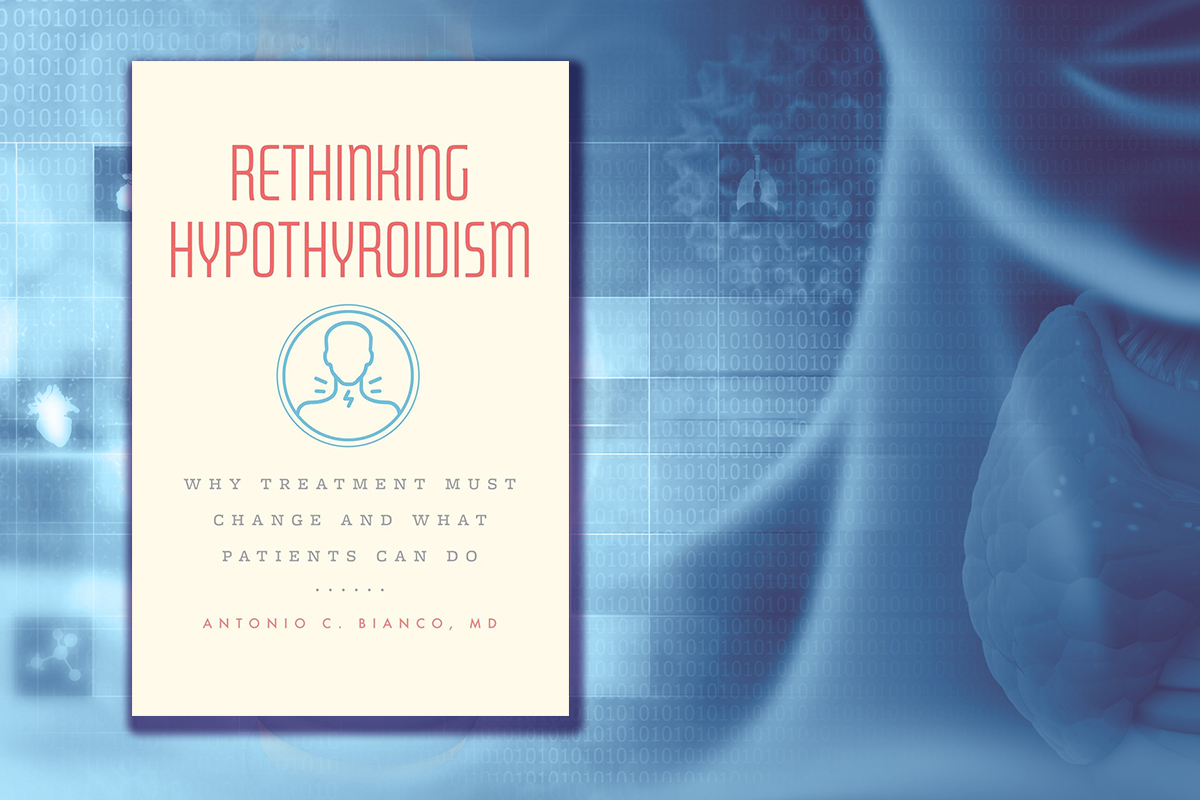Dr. Antonio Bianco, recipient of the American Thyroid Association’s John B. Stanbury Thyroid Pathophysiology Medal, is professor of medicine and a member of the Committee on Molecular Metabolism and Nutrition at the University of Chicago, where he runs a laboratory funded by the National Institutes of Health to study thyroid hormones. Dr. Bianco is also a former president of the American Thyroid Association.
His recent book, Rethinking Hypothyroidism: Why Treatment Must Change and What Patients Can Do, is a primer for patients, their families, and their doctors that explains why the standard treatment for hypothyroidism fails many—and offers an empowering call for change. He recently joined me for an episode of my Intelligent Medicine podcast.
Dr. Bianco explains that, while it may seem straightforward for doctors to administer standard thyroid medications like Synthroid and adjust dosages according to the results of thyroid blood tests . . .
“For about 10–20% of patients on the leading treatment—millions in the United States and around the world—that treatment is not working. In this book, I argue that my fellow physicians need to take their patients’ complaints seriously and give them more options.”
In “Rethinking Hypothyroidism” he meticulously documents the history of thyroid therapy from its inception in the 19th century to the enthronement of dogmas that currently limit patients’ access to more nuanced treatments:
“The story of hypothyroidism treatment presents a solution, followed by a mystery. Why did so many of those treated for hypothyroidism ultimately fare so poorly? How was a century-long medical triumph transformed into a tarnished victory, fraught with conflict and exhaustion? Why did doctors dismiss the millions of patients insisting their treatments were failing; and why did patients find themselves suddenly doubting decades of reliable, tested science?”
As an influential academic endocrinologist, Dr. Bianco deserves credit for heeding the complaints of patients and stepping out of the box to articulate a problem that has long guided my approach to hypothyroidism (see my 2016 article “The ugly truth emerges about synthetic thyroid medication”):
“ . . . a fraction of the patients treated for hypothyroidism (one and a half million to three million individuals in the United States) is far from living a normal life. Even though blood tests indicate their treatment is on target, these patients experience residual symptoms. They complain of what they call “foggy brain,” mental confusion, difficulty making decisions, and poor memory. They also suffer from fatigue and difficulty managing body weight.”
“Unfortunately,” he says, “physicians have been slow to recognize and treat these residual symptoms . . . My goal is to improve the quality of life of all patients with hypothyroidism.”
By the late 19th century, it was recognized that offering ground up extracts of animal thyroid to patients with the characteristic symptoms of hypothyroidism could alleviate their symptoms. Of necessity, these treatments were imprecise because there were no blood tests to guide dosing. Thyroid extracts contained both T4 and T3, roughly matching the natural output of the human thyroid.
In the 70s, a move was made to replace “unreliable” thyroid formulations derived from animal glands to synthetic thyroid containing T4 alone. Synthroid (l-thyroxine) was ensconced as the “standard of care.” After interviewing veteran endocrinologists who practiced in that era, Dr. Bianco discovered that fully one quarter of the patients switched to the modernized medication complained and wanted to revert to their original natural thyroid.
“In retrospect, I can’t help but wonder why most of us ignored these early warnings and so easily wrote off patients’ complaints without questioning the effectiveness of T4,” he writes.
Indeed, I still encounter this unjustified prejudice by conventional endocrinologists, who, upon learning that I’ve prescribed porcine thyroid extract to our patients in common, deride it as “piggy thyroid—that’s so out of date!”
The problem, argues Dr. Bianco, is that we’re no longer treating the patient—we’re treating their blood tests. The TSH test was codified as the arbiter of the need for thyroid medication, and how much is sufficient.
Dr. Bianco shares a typical patient complaint:
“I was diagnosed hypothyroid fifteen years ago. Following that diagnosis, for the reasons you mentioned, finding treatment that was effective for and acceptable to me was difficult as the four doctors and endocrinologists I visited just didn’t listen and wouldn’t talk with me. There was an established treatment; do it and we don’t want to talk about it. I distinctly remember an endocrinologist I visited to discuss the questions I had after doing my research and he leaned over, patted my knee and said, ‘You let me worry about all that, dear’.”
Indeed, there’s an element of medical patriarchy here; the majority of hypothyroid patients are female, easily dismissed by predominantly male physicians as hypochondriacal. What’s next? Often a referral to a psychiatrist for an antidepressant.
Pharmaceutical companies engaged in their usual shenanigans to shore up the thyroid orthodoxy. Flint (later Boots), maker of Synthroid, sent fleets of drug reps to doctors’ offices, had ghost writers pen journal articles under the imprimatur of prominent physician influencers, contributed money to professional medical associations, offered trips and gifts to frequent-prescribers, and then, when a comparable cheaper generic T4 threatened Synthroid’s market dominance, attempted to deep-six a study that showed the generic was just as effective as the pricier brand medication.
A little physiology is in order here. Dr. Bianco explains:
“The thyroid gland produces a mixture of iodine-containing hormones, of which T4 and T3 are the most relevant. Almost all thyroid secretion is T4, and yet T4 is not an active hormone. In other words, organs do not respond to T4. To become active, T4 must be transformed to T3. T3 is the active hormone, responsible for the effects of thyroid secretion throughout the body.”
Therefore, the challenge to the efficacy of T4 alone formulations is T4’s inconsistent transformation to T3, which occurs in tissues and target organs outside the thyroid gland. Poor conversion shortchanges the body. But giving T3 also has problems: It’s fast-acting and may cause speedy side effects, including revving the heart into dangerous arrhythmias. Plus, T3 adequacy is difficult to quantitate with current tests; what appears in the blood may not accurately reflect what’s in the cells, where T4-T3 conversion occurs.
The principal enzyme that catalyzes the conversion of T4 to T3 is deiodinase. Of three types, deiodinase 2 (D2) is most prevalent. Dr. Blanco describes little-known research that demonstrates D2 levels are decreased when T4 is administered as a solo therapy—putting the brakes on conversion. Hence, T3 is throttled down when it’s most needed. You can find a great summary with excellent graphics at http://deiodinase.org.
There’s also the impact of deiodinase polymorphisms; some people are genetically predisposed to less efficient conversion of T4 to T3. This may partially explain why the majority of patients respond well to standard thyroid, while a significant minority don’t feel well until some T3 is added to their regimens.
Is iodine at fault here? Dr. Bianco explains that iodine is a limiting factor in thyroid hormone production; hypothyroid goiter was once rampant in parts of the world where seafood intake was rare, soils were depleted of iodine, and salt was not iodine-fortified. That’s mostly been remedied. On the other hand, excess iodine won’t help—and may even depress thyroid function.
Selenium has a role to play as well, as an antioxidant co-factor with glutathione that protects the thyroid from autoimmune attack.
Current T3 formulations like Cytomel are rapid-acting when what’s called for is steady-state bioavailability. A partial solution has been time-release T3. Various matrices and encapsulation methods have been tried, but digestion and absorption are highly variable between individuals. The “Holy Grail” of thyroid therapy is to develop reliable methods for delivering T3 without peaks and valleys, which Dr. Bianco discusses in “Rethinking Hypothyroidism”:
“ . . . pharmaceutical companies need to develop an improved delivery system for T3, one that could avoid the spikes in T3 levels and could therefore be used more broadly by patients with hypothyroidism, without safety concerns.”
Ultimately, Dr. Bianco suggests, regenerative medicine may deliver targeted stem cell therapies that restore normal function to under-performing glands. While not yet ready for primetime, these approaches are being actively investigated.
Meanwhile, with the practical and theoretical evidence so convincingly summarized by Dr. Bianco in Rethinking Hypothyroidism, I’ll be fortified in my decades-long resolve to provide my patients with the best thyroid care—with synthetic or natural formulations as appropriate, heeding all necessary precautions until new options arise to address the crucial role of T3.







